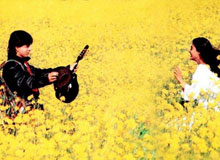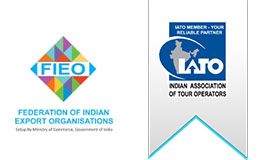History
Indian Cinema
Cinema of India

India has one of the oldest and largest film industries in the world. It was in early 1913 that an Indian film received a public screening. The film was Raja Harischandra. Its director, Dadasaheb Phalke is now remembered through a life-time achievement award bestowed by the film industry in his name. At that point of time it was really hard to arrange somebody to portray the role of females. Among the middle classes, that association of acting with the loss of virtue, female modesty, and respectability has only recently been put into question.
While a number of other film-makers, working in several Indian languages, pioneered the growth and development of Indian cinema, the studio system began to emerge in the early 1930s. Its most successful early film was Devdas (1935), whose director, P.C. Barua also appeared in the lead role. The Prabhat Film Company, established by V. G. Damle, Shantaram, S. Fatehlal, and two other men in 1929, also achieved its first success around this time. Damle and Fatehlal's Sant Tukaram (1936), made in Marathi was the first Indian film to gain international recognition.
The social films of V. Shantaram, more than anything else, paved the way for an entire set of directors who took it upon themselves to interrogate not only the institutions of marriage, dowry, and widowhood, but the grave inequities created by caste and class distinctions. Some of the social problems received their most unequivocal expression in Achhut Kanya ("Untouchable Girl", 1936), a film directed by Himanshu Rai of Bombay Talkies. The film portrays the travails of a Harijan girl, played by Devika Rani, and a Brahmin boy, played by Ashok Kumar.
The next noteworthy phase of Hindi cinema is associated with personalities such as Raj Kapoor, Bimal Roy, and Guru Dutt. The son of Prithviraj Kapoor, Raj Kapoor created some of the most admired and memorable films in Hindi cinema.
Awaara (The Vagabond, 1951), Shri 420 (1955), and Jagte Raho (1957) were both commercial and critical successes. Bimal Roy's Do Bigha Zamin, which shows the influence of Italian neo-realism, explored the hard life of the rural peasantry under the harshest conditions. In the meantime, the Hindi cinema had seen the rise of its first acknowledged genius, Guru Dutt, whose films critiqued the conventions of society and deplored the conditions which induce artists to relinquish their inspiration. From Barua's Devdas (1935) to Guru Dutt's Sahib, Bibi aur Gulam,the motif of "predestined love" looms large: to many opponents, a mawkish sentimentality characterizes even the best of the Hindi cinema before the arrival of the new or alternative Indian cinema in the 1970s.
It is without doubt that under the influence of the Bengali film-makers like Satyajit Ray, Ritwik Ghatak, and Mrinal Sen, the Indian cinema, not only in Hindi, also began to take a somewhat different turn in the 1970s against the tide of commercial cinema, characterized by song-and-dance routines, insignificant plots, and family dramas. Ghatak went on to serve as Director of the Film and Television School at Pune, from where the first generation of a new breed of Indian film-makers and actors - Naseeruddin Shah, Shabana Azmi, Smita Patil, and Om Puri among the latter was to emerge
These film-makers, such as Shyam Benegal, Ketan Mehta, Govind Nihalani, and Saeed Mirza, exhibited a different aesthetic and political sensibility and were inclined to explore the caste and class contradictions of Indian society, the nature of oppression suffered by women, the dislocations created by industrialism and the migration from rural to urban areas, the problem of landlessness, the impotency of ordinary democratic and constitutional procedures of redress, and so on.
The well-liked Hindi cinema is characterized by important changes too numerous to receive more than the slightest mention. The song-and-dance routine is now more systematized, more regular in its patterns; the 'other', whether in the shape of the terrorist or the unalterable villain, has a more gloomy presence; the nation-state is more fixated in its demands on our loyalties and curtsy; the Indian Diaspora is a larger presence in the Indian imagination and so on. These are only some considerations: anyone wishing to discover the world of Indian cinema should also replicate on its presence in Indian spaces, its relation to vernacular art forms and mass art.
The Indian film industry, famously known as Bollywood, is the largest in the world, and has major film studios in Mumbai (Bombay), Calcutta, Chennai, Bangalore and Hyderabad. Between them, they turn out more than 1000 films a year to hugely appreciative audiences around the world. For nearly 50 years, the Indian cinema has been the central form of entertainment in India, and with its increased visibility and success abroad, it won't be long until the Indian film industry will be well thought-out to be its western counterpart- Hollywood. Mainstream commercial releases, however, continue to dominate the market, and not only in India, but wherever Indian cinema has a large following, whether in much of the British Caribbean, Fiji, East and South Africa, the U.K., United States, Canada, or the Middle East.
Indian Art Cinema
India is well known for its commercial cinema, better known as Bollywood. In addition to commercial cinema, there is also Indian art cinema, known to film critics as "New Indian Cinema" or sometimes "the Indian New Wave" (see the Encyclopedia of Indian Cinema). Many people in India plainly call such films as "art films" as opposed to mainstream commercial cinema. From the 1960s through the 1980s, the art film or the parallel cinema was usually government-aided cinema.
Indian Commercial Cinema
Commercial cinema is the most popular form of cinema in India. Ever since its inception the commercial Indian movies have seen huge following. Commercial or popular cinema is made not only in Hindi but also in many other regional languages of East and South India. Let's look at some of the general conventions of commercial films in India. Commercial films, in whatever languages they are made, tend to be quite long (approx three hours), with an interval. Another important feature of commercial cinema in India is music.
Regional Cinema India
India is home to one of the largest film industries in the world. Every year thousands of movies are produced in India. Indian film industry comprises of Hindi films, regional movies and art cinema. The Indian film industry is supported mainly by a vast film-going Indian public, though Indian films have been gaining increasing popularity in the rest of the world, especially in countries with large numbers of emigrant Indians.



